
THE LITHUANIAN WOMAN IN LEGEND AND HISTORY
No one has contributed more to the preservation o f Lithuania’s national identity — and perhaps its very existence — than the Lithuanian woman.
Throughout all the turbulent times o f Lithuanian history; the Lithuanian woman played an important role and often assumed heavy burdens and responsibilities for the preservation of the nation’s identity and even its very existence. The Lithuanian woman was glorified in legend and epic. As queen, princess, noblewoman, she distinguished herself in the Lithuania o f Kings and Grand Dukes. Centuries later, during the national renaissance, even as a simple farmer’s wife, she was seen asserting herself and helping to pave the way for the restoration of Lithuania’s independence. When independence came, with fresh energy she shouldered new duties and earned for herself new laurels in every field o f national life.
In our treatment of the Lithuanian woman, we have limited our choice to representative women from antiquity to the restoration of Lithuanian independence in 1918. To avoid confusion in the mind of the reader unacquainted with the intricacies of the Lithuanian language, women’s surnames in nearly all instances are written in the masculine form.
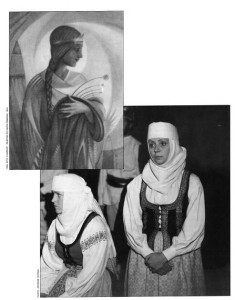
IN LEGEND AND EARLY HISTORY
Since time immemorial, Lithuanians have had their V ideal of womanhood. Their symbolic and animisj tic mythology embodied the feminine ideal in a sylvan or water sprite, which they called laume, a being that is akin to the good fairies of Western European folklore. This spirit-maid, surviving to this day in hundreds of folk tales, was a symbolic personification of the ideal Lithuanian woman: tall, flaxen-haired, blue-eyed,buxom maiden, with calm and melodious voice; a compassionate nurse and industrious maternal guardian of the aged and the children.
Legends—folk creations of a bygone humanistic or romantic era—have given us many types of women. Some of these legendary women are sublimated examples of heroic Lithuanian maidens. Such, for instance, was Pajauta, the chaste daughter of the chief druid Lizdeika. Folk tradition has it, that rather than marry a foreign non-believer and thereby betray the old pagan religion, she sacrificed herself to the wolves.
A second Pajauta was the beautiful daughter of Duke Kernius. She led an exemplary life as spouse and mother and was respected by her subjects. When she died, her son Kukovietis erected a wooden monument in her memory on the shore of Lake Žasliai. In time, this wooden monument rotted and fell away, but in its place emerged a miraculous linden tree.
Loyalty was another feminine virtue extolled in historical legends.
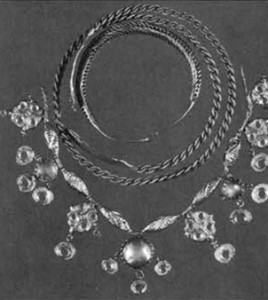
Gražina, the wife of Liutaveras, Duke of Naugardukas, learned that her husband was plotting with the Teutonic Knights against his liege lord Vytautas. Donning her husband’s armor, Gražina led the forces of Naugardukas against the invading Teutonic Knights. Though the Knights were soundly defeated, Gražina fell in battle, preserving the honor of her household.
Another princess of Naugardukas was Živile, whose father would not permit her to marry her lover of lower rank. The lover, however, was determined to free her from her father’s clutches and with a band of Ruthenians forced his way into the castle. But Zivile’s loyalty to her father and his people was stroger than her love for the swain. She stabbed her would-be rescuer and ralied the men-at-arms of the castle to rout of enemy, Zivile stabbed herself to death, to atone for the strife she had caused.
IN THE LAND OF KINGS AND PRINCES
The first Lithuanian woman known in history is Queen Morta (Martha), wife of King Mindaugas, creator of the Lithuanian State. The stature of this renowned couple assumes monumental proportions in Lithuanian history of the thirteenth century. It was Mindaugas and Morta who accepted Christianity for the Lithuanian nation in 1251. Two years later Morta was crowned queen. An energetic and ambitious woman, she not only performed her family duties with dignity, receiving foreign envoys in the regal castles, but she also participated in the political activities of her husband, who spun intrigues against the Teutonic Knights, an aggressive crusading order recently established on the Baltic shores and scheming to plunder Lithuania. Queen Morta was Mindaugas’ adviser and assistant. Friends and strangers alike had to reckon with her. She died earlier than Mindaugas, the exact date being unknown.
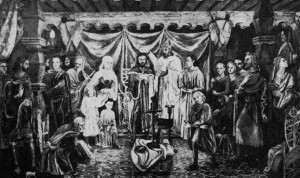
In the next century another woman enters the spotlight of Lithuanian history. She is Aldona, the daughter of the ruler, King Gediminas. Because of reasons of state, namely, Lithuania’s need to effect an alliance against the growing threat of the Teutonic O rder, Aldona was married to Wladislaw Lokietka’s son Casimir, who was later known as King Casimir the Great. For her dowry she asked her father for the return of 25,000 Polish prisoners of war to Poland—a country whose queen she was about to become. Amid universal acclaim and blessings, Aldona journeyed from Vilnius to Cracow, Poland’s capital. Unfortunately, she did not fare well in her new country. Her husband proved unfaithful. The queen sought solace in charitable work and music. She died a young woman, leaving two daughters, who later married into the Luxembourg and Habsburg families of the Holy Roman Empire. Aldona’s granddaughter became the wife of Emperor Charles IV.
The fate of Birute was different. To this day she is surrounded by emotional legends and a veil of poetry. This daughter of a Samogitian Duke from the Palanga seacoast became the wife of King Kestutis and the mother of the genius Vytautas the Great. Birute came to be regarded as guardian of the Lithuanian national hearth and symbol of dedicated Lithuanian motherhood. A mound held to be her burial site is still kept in high esteem after more than six hundred years.
Birute’s son, Vytautas, had an illustrious spouse, Ona, sister of Lord Sudimantas.
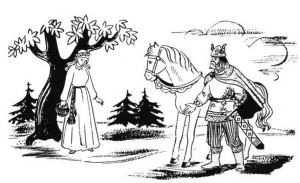
The personality of Ona (Anna) is characteristic of the typical Lithuanian woman. A mother— but not merely a mother, she was a boon companion of her husband. She was never satisfied with only the maintenance of the household. Her interests were wide. She was a public figure and a politically-minded woman. (The women in Lithuania had been enjoying full freedom and taking part in public activities since olden times.) Ona loved honors, but she also knew how to make sacrifices. She did not avoid obstacles, but overcame them. During the political chaos in Lithuania toward the end of the fourteenth century, when her husband was thrown into prison by his wily cousin Jogaila, she assumed responsibility and devised a way for his escape by exchanging her clothes with him, letting him walk out in disguise while she remained in prison.
Free once more, Vytautas forced his cousin to recognize him as Grand Duke of Lithuania.
Under Vytautas Lithuania became one of the most powerful states of Europe. After Jogaila was crowned King of Poland, Vytautas became a virtual sovereign of the Lithuanian Grand Duchy. Ona was his co-worker. She signed writs of warranty which her husband would fulfill, received emissaries of the Teutonic Knights, went to their capital Marienburg as a hostage to advance her husband’s political cause. She stood firmly at his side when war broke out with the Teutonic Order of Prussia and Vytautas with Jogaila dealt the Teutonic Knights a mortal blow in the battle of Žalgiris (Tannenberg) in 1410. Ona died in 1418, without seeing the day the Holy Roman Emperor granted her husband a royal crown. In the chronicles of the Teutonic Knights Ona is described as “The most elegant woman in Europe.”
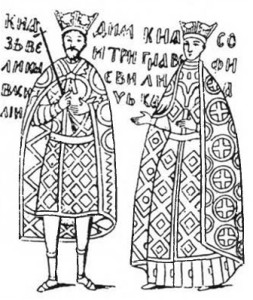
an old woodcut.
The only daughter of Vytautas and Ona was Sofia, an energetic and strong-willed woman, who married the Grand Duke of Moscow. Though living in an alien environment where women were traditionally kept in the terema, the Muscovite equivalent of the oriental harem, Sofia did not accept this strange custom. She was not a slave to her husband, but actively engaged in the politics of the Kremlin. After her husband died she doggedly fought for her son’s rights to the throne. While her father Vytautas was alive, she felt secure, seeking his protection over her family. After his death she continued her firm rule in the Kremlin, although she was driven from the throne and even imprisoned.
She ultimately regained the throne for her son, chose a wife for him, and defended Moscow against the inroads of the Tartars. When Jogaila became the king of Poland, ushering in the renowned Jagelonian Dynasty, his sister Aleksandra exercised great influence in Polish politics. Aleksandra had married the Duke of Mazovia. She went down in posterity as cofounder, with Jogaila, of the University of Cracow. Her capable daughter was to be the mother of the Habsburg Emperor, Frederick IV. The fourth wife of Jogaila was a Lithuanian, Sofia, Duchess of Alšenai. She was the first queen of Poland to see to it that her subjects had the Holy Scriptures in their native language. She played a prominent role in having her offspring chosen as rulers of Poland and Lithuania.
From the fourteenth to the middle of the sixteenth century, a heated conflict between the Lithuanians and the Poles raged over the political union of the two states. The Lithuanians sought to break the ties with the Poles, while the latter wanted a closer union. These strained relations can be seen in the fate of Duchess Barbora Radvila, whose brother and cousin were high dignitaries of Lithuania.
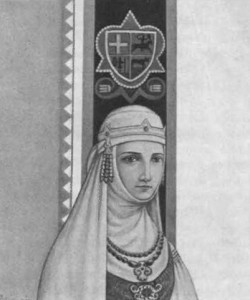
Duchess Barbora was a ravishing beauty and a true child of the epoch of humanism and the Renaissance. Her love affair with Lithuania’s Grand Duke Žygimantas (Sigismund August) led to a stormy episode in Polish-Lithuanian history. The ruler’s mother and the Polish nobles were opposed to the marriage of the heir to the Polish throne to the daughter of Lithuania’s most influential family. “I would rather see in Cracow the Turkish Sultan than see her as queen of Poland,” said many a Polish magnate. Conventions and parliamentary assemblies discussed the question of the ruler’s wedding. After days of waiting, fear, and insults, the young couple married in secret. Finally, the vacillating Sigismund August became king of Poland and had Barbora crowned queen. But their joy was short-lived. Weakened by a long illness (it is said that the dowager queen Bona poisoned her), Queen Barbora died, a victim of the quarrels between the Lithuanian and Polish nobility.
Among the leading lights of the Renaissance period in Lithuania is the personality of Sofia Vnucka Morkus, a wealthy estate owner and an advocate of Calvinism and secular education. Her contemporary was Sofia Chodkevicius (Katkus), who exerted an influence on the illustrious hetman (military marshal) Jonas Karolis Chodkevicius (Katkus). She was an independent woman, who managed vast estates and built churches and monasteries. One of the most educated and influential women of the eighteenth century in Lithuania was Zabiela-Kosakauskas. The list could be expanded indefinitely.
DURING THE ECLIPSE OF LITHUANIAN LIBERTY
From 1795 to 1918 was a long and difficult period that followed Imperial Russia’s annexation of Lithuania. During those years the Lithuanians repeatedly rose against the czarist despotism, women joining their men folk in the struggle to restore the nation’s freedom and independence. In the 1831 rebellion, Countess Emilija Plateris, a patriotic Samogitian girl, distinguished herself as a guerilla colonel and died from wounds received in combat. Two other Samogitian noblewomen, Marija Asanavicius and Antuane t e Tamašauskas, who gained recognition for their great courage on the battlefield, were fortunate to survive, but were obliged to leave the country and, fearing Russian persecution, did not return.
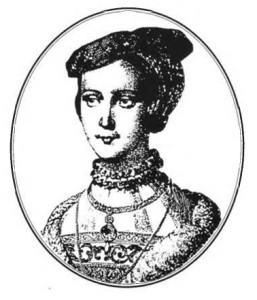
In the same 1831 uprising Princess Kunigunda Oginskis achieved distinction for her heroic devotion as a nurse to the wounded rebels. With her husband, General Gabrielius Oginskis, who had led the Lithuanian units during Napoleon’s march on Moscow in 1812 and who was now Vice-President of Lithuania’s temporary government, she shared the trials and dangers of underground warfare. After the suppression of the revolt, she and her husband emigrated to France. Later, with the Czar’s permission, they returned to Lithuania. It was her fate, however, to experience the tragic loss of her husband, who was seized and tortured by the Russians and died in a Vilnius prison.
The rebellion was suppressed with great bloodshed. The old University of Vilnius, a fountainhead of national thought and aspirations, was closed. Men and women who participated in the rebellion were deported to Siberia. Some succeeded in escaping to the West.
In the 1863 revolt, the sisters of Liudvikas Narbutas, one of the leaders of the revolt— Teodora Monciunskas and Emilija Jucevicius—stand out as women rebels. Teodora supported her brother’s unit as an active liaison runner. Emilija sheltered the units of Ostroga and Lenkevicius. Kazimiera Žebrauskas helped the units of Saurimavicius and Olšauskas in Ukmerge and Panevežys counties. Karolina Gouvaltis residing in Vilnius helped volunteers, hid and clothed rebels.
Women also gave food, shelter, and other aid to the families of men who joined the revolt. Many women were subjected to punishment because their men were in rebel ranks. Without doubt, Dominika Dalevskis, a widow in Vilnius, suffered the most. Her son Titas was executed in Vilnius. Another son, Pranciškus, received a twentyyear hard labor sentence. Konstantinas migrated to France. Aleksandras, returning from Siberia, died in Vilnius before the revolt. Mrs. Dalevskis and her six daughters were deported to the depths of Russia. Banishing her to Ufa province, Governor General Muraviev declared: “Let this mother, who has nurtured so many mutineers, settle near the road to the penal camps. Let her observe her sons, relatives and friends being driven along this road in chains.” On this road Mrs. Dalevskis saw Pranciškus being taken to Siberian exile. The son, as told by Apolonija Sierakauskas— another woman in exile who witnessed the meeting—fell at his mother’s feet, while she only pressed his head to her breast, without a sob or a tear.
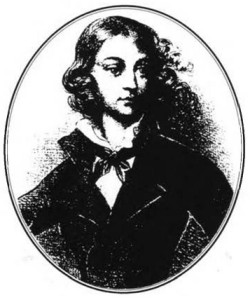
Russian gendarmes sent hundreds of rebels to the gallows, Thousands were deported to desolate wastelands of Russia. All Lithuanian schools were closed. Obscurantism clouded the horizon. In 1864 the Lithuanian language was banned in all public offices, and the use of Latin characters in Lithuanian publications was prohibited.
The reactionary czarist regime in Lithuania began a policy against the Catholic Church. This was coupled with Russification and colonization of sequestrated lands by Russian settlers. Dark days had indeed descended upon Lithuania.
During the struggle against Russia, Lithuania lost many of her notables and intellectuals. The only positive development was the abolition of serfdom in 1861, which permitted the sending of peasant children to school. As a consequence, a generation of intellectuals of peasant background sprang up, which took up the struggle for the peasantry and for the nation as a whole. They were, without doubt, the prototypes of the Lithuanian youth a century later that rose up to wage open and guerilla warfare against the overwhelming forces of the Russian Soviets, who had occupied their country and had deported countless thousands of their relatives and neighbors to the barren reaches of Siberia.
In the struggle with the czarist government, women were active participants—not as wives of kings and dukes, but as peasant women. During and after the period of serfdom it was the Lithuanian peasant women who did so much to preserve their ancient language. Seated at her spinning wheel, the Lithuanian mother taught her children to read in the native language. She told them stories and legends about the country’s great past when the land was free and powerful. These legends survived, being passed on from generation to generation. The Lithuanian woman knew that she would be punished for this, but her love of her country was stronger than her fear of punishment.
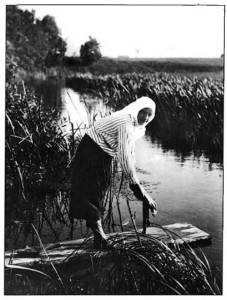
The Lithuanian woman was brave. When the Russian authorities ordered the church at Kražiai in 1893 shut down to prevent the people from praying in Lithuanian, the women would not abandon this sanctuary. Thereupon the Russian gendarmes broke in among the worshipers and hacked them with their swords. But the Lithuanian woman bravely and patiently bore her suffering. It was her way of protesting against the regime for forbidding the worship of God in her own language.
The political maturity of the woman runs like an unbroken thread throughout Lithuanian history. Women were among the devoted book smugglers who clandestinely brought into the country Lithuanian books and newspapers, printed in East Prussia and the United States, and distributed them among the common folk hungry for the forbidden Lithuanian word. For their patriotic work many of these book carriers were arrested and banished to Siberia. Among the most prominent women who directed book smuggling from Tilže (East Prussia) was Morta Zaunius, who later helped to organize the Lithuanian exhibit at the World’s Fair in Paris in 1901.
In 1883 the fledgling Lithuanian newspaper Aušra formulated the national aspirations, demanding reestablishment of the Lithuanian press and the opening of more schools. By 1889 another Lithuanian newspaper, Varpas, was asking for acknowledgment of national rights, land reform, civil rights for all, and ultimately national independence.
After years of constant struggle, the Lithuanian press was finally restored in 1904.
The 1905 revolution in Czarist Russia had repercussions in Lithuania. Uprisings broke out all over the country, and regional functionaries of Russia were swept aside in the rural areas. On September 22-23, 1905, the Alliance of Women of Lithuania was formed. The goal of the country’s first women’s organization was the restoration of the Lithuanian State and securing of women’s rights. (Russian law accorded very limited rights to women, especially in the field of inheritance).
That same year a Lithuanian Conference was called in Vilnius. It was attended by two thousand delegates. Women actively participated in the work of this conference. Its resolutions demanding human and political rights for Lithuania later circulated throughout the country. Gabriele Petkevicius, Felicija Bortkevicius, Ona Šapkauskas, Katre Jane lis, and Ona B raza us kas were among the vocal women at the conference.
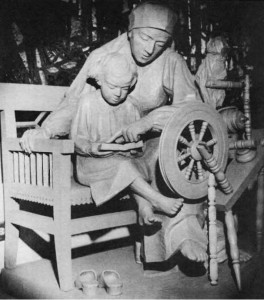
At the end of 1905 a meeting of peasant women took place at Lotove- nai, in Šiauliai County. The women declared that they must have equal rights with men. Being subject to the same taxes, they argued, their rights should also be the same. They also demanded Lithuanian language schools, protested against unrestricted sale of liquor, and came out in favor of a strong, nationwide women’s society.
Growing czarist reaction, however, ruined their hopes. The reprisals were similar to those that took place after the 1831 and the 1863 revolts. Again many Lithuanian patriots were banished to Siberia, while others managed to escape to western Europe and America. Among the emigrants to America were young men fleeing from service in the Czar’s army. Lithuanian women sent their sons abroad that they may escape doing military duty in the Caucasus, Turkestan, and Far Siberia.
In 1907 the first Women’s Conference took place in Kaunas. Because of possible political reaction, the women had to formulate their demands carefully. The conference, with Gabriele Petkevicius as chairman and Ona Pleiris-Puida as secretary, saw a need for a general women’s organization. The meeting raised the question of women’s rights, suggested that women also organize by profession, concern themselves with education, and protest against the government’s open sale of liquor.
In 1908 two women’s organizations were founded—the Lithuanian Catholic Women’s Society in Kaunas and the Lithuanian Women’s Association in Vilnius.
Prior to the First World War, the national political work of women was clandestine. Women often engaged in underground party activities. They peasant women took place at Lotove- nai, in Šiauliai County. The women declared that they must have equal rights with men. Being subject to the same taxes, they argued, their rights should also be the same. They also demanded Lithuanian language schools, protested against unrestricted sale of liquor, and came out in favor of a strong, nationwide women’s society. Growing czarist reaction, however, ruined their hopes. The reprisals were similar to those that took place after the 1831 and the 1863 revolts. Again many Lithuanian patriots were banThe goal of the country’s first women’s organization was the restoration of the Lithuanian State and securing of women’s rights. ished to Siberia, while others managed to escape to western Europe and America. Among the emigrants to America were young men fleeing from service in the Czar’s army. Lithuanian women sent their sons abroad that they may escape doing military duty in the Caucasus, Turkestan, and Far Siberia. In 1907 the first Women’s Conference took place in Kaunas. Because of possible political reaction, the women had to formulate their demands carefully. The conference, with Gabriele Petkevicius as chairman and Ona Pleiris-Puida as secretary, saw a need for a general women’s organization. The meeting raised the question of women’s rights, suggested that women also organize by profession, concern themselves with education, and protest against the government’s open sale of liquor. In 1908 two women’s organizations were founded—the Lithuanian Catholic Women’s Society in Kaunas and the Lithuanian Women’s Association in Vilnius. Prior to the First World War, the national political work of women was clandestine. Women often engaged in underground party activities. They Year o f the Lith u a n ia n Bo o k helped liberate political prisoners and arranged their escape abroad. They edited clandestine and public newspapers and wrote articles on women’s rights. They were often under police surveillance.
When the Kaiser’s armies occupied Lithuania in 1915 and the retreating Russians transported part of the population to Russia Proper, Lithuanian women faced adversity with patience and fortitude. With the fall of the Russian colossus during the March 1917 revolution, Lithuanian women in Russia organized in groups, in order to speed up their return to their homeland. In Moscow they formed the Lithuanian Women’s Freedom Union, with Ona Mašiotas as its suffragette-type chairman.
During the Lithuanian Conference in Petrograd (St. Petersburg) in May of 1917, the women participants—among them: Felicia Bortkevicius, Liuda Purenas, Birute Grigaitis, and Emilija Spudas-Gvildys —insisted that the assembly extend equal rights to women, and their demand was accepted in resolution form. During the German occupation, the Vilnius-based Committee to Aid War Victims was for a long time the only official Lithuanian institution. Two of its more active members were Emilija Vileišis and Sofia Smetona.
On February 16, 1918, Lithuania declared her independence. Even before the impending collapse of Imperial Germany, many refugees had started on their return journey from Russia. The Lithuanian women were going back to rebuild their homeland.
Jadvyga Chodakauskas was among the first women to be sent abroad. In 1918 she headed the Lithuanian Information Center in Bern, Switzerland. For a while she was the representative of Lithuania in Switzerland. In 1919 she went to Paris with the Lithuanian Peace Delegation as the Director of the Lithuanian Information Center.
• This article was adapted from The Lithuanian Woman, edited by Birute Novickis and published by the Federation of Lithuanian Women’s Clubs, Brooklyn, 1968
 DRAUGAS NEWS Lithuanian World Wide News in English
DRAUGAS NEWS Lithuanian World Wide News in English
